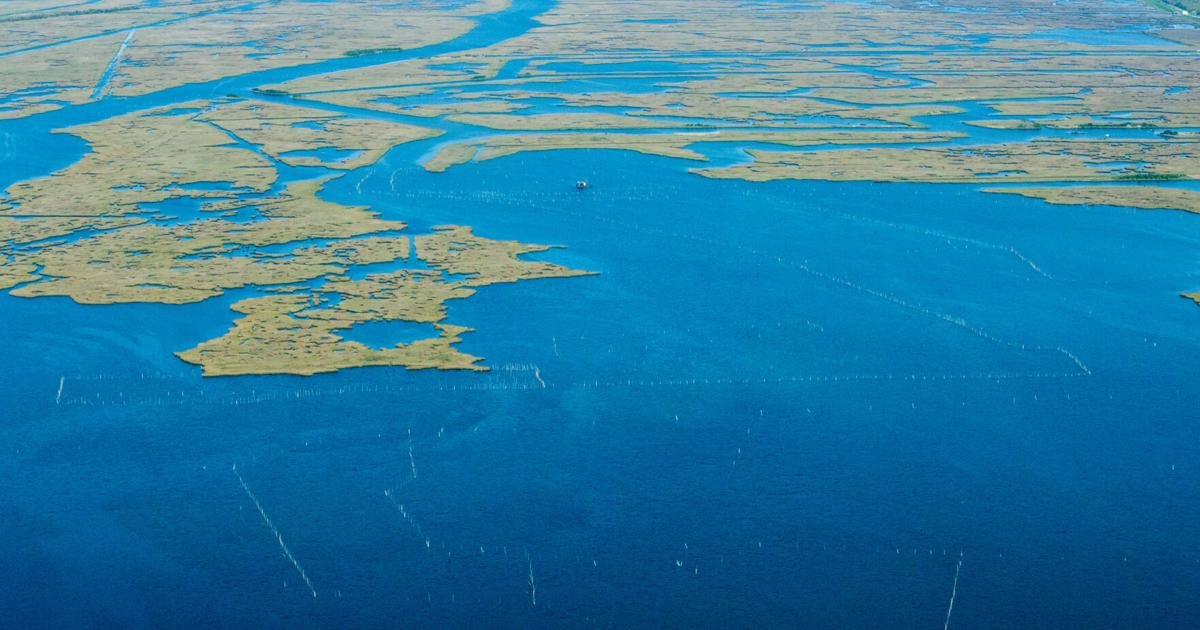
Should Louisiana’s $2 billion Mid-Barataria Sediment Diversion project be built, at full capacity it could move 40,000 tons of clay, silt and sand per day from the Mississippi River into the degraded wetlands and bays off Plaquemines Parish’s west bank. That’s more than triple the weight of the Eiffel Tower, and all that new sediment is bound to compress the mud and earth beneath it, causing an even faster sinking of the very land that Louisiana is trying to save.
But two new academic studies suggest the river diversion will likely outpace the rapid subsidence rate and build land faster than it sinks.
“What both studies show is that despite this accelerated subsidence that happens due to renewed deposition, … there are still significant areas that can see a pretty decent amount of elevation gain,” said Torbj?rn T?rnqvist, a Tulane University geology professor who co-authored the studies.
Category 4 storm’s surge, waves ripped up marsh grasses and washed them away
The new findings help to build the case for constructing large-scale sediment diversions, a cornerstone of the state’s 50-year, $50 billion plan to restore a portion of Louisiana’s lower third amid a longstanding land loss crisis exacerbated by global warming and the rising sea. Much of the state’s Coastal Master Plan centers on building land through dredging, using pipelines to transport sediment from one location to another, but diversions mimic how the Mississippi River built Louisiana: sending sediment-rich water beyond the river’s banks to fill areas nearby.
The new studies ran in parallel. One looked at a site near Myrtle Grove, the location of the planned Mid-Barataria Sediment Diversion, and the other focused on land growth around the head of Bayou Lafourche, near modern-day Donaldsonville. The research aimed to understand how much the increased sediment load affects subsidence, a natural process in which land gradually sinks, and how that in turn affects the development of a delta.
Examining a 131-foot-long core of earth taken from Myrtle Grove, University of Oregon postdoctoral scholar Molly Keogh, the lead author of one study, got a peek into how land elevation increased over the course of the Holocene Epoch, beginning about 11,500 years ago. She used that to model the land compaction.
Because of increasing rates of sea level rise fueled by global warming, the remaining 5,800 square miles of Louisiana’s coastal wetlands in th…
Overall, most of the immediate effects of new sediment were seen in the top 10 feet. Every future scenario that Keogh modeled resulted in net elevation gain from muddy water leaving the Mississippi and entering the Bayou Lafourche area. The gain ranged from 1 centimeter to almost 6 feet over a century, which can make a huge difference for Louisiana’s low-lying wetlands.
The biggest factor? How much sediment was flowing into the area.
“The scenarios that we modeled that had the most net elevation gain were ones where more sediment was put into the wetland,” Keogh said. “A bigger diversion makes more deposits, more sediment. It causes more compaction, but it also causes more net elevation gain.”
To the southeast, Elizabeth Chamberlain, an assistant professor of soil geography at Wageningen University in the Netherlands, looked at the stratigraphic record of the Lafourche delta and its outward growth. Her study found that “despite rapid shallow subsidence during bayhead delta progradation, sediment compaction has a limited effect on the rate and magnitude of land-building.”
$800 million coastal land-building project downsized from 47 to 31 square miles
“In this regard, it can be viewed as a hopeful finding” for Louisiana’s coastal restoration efforts, Chamberlain said. “We found that that amount of subsidence – even though it can be relatively high at the depositional site – it doesn’t impact the growth rate very much.”
T?rnqvist cautioned that land-building will likely require decades before the effects are visible in areas that are now open water. The most compaction happens early on, when new sediment first accumulates and squeezes together the underlying deposits.
“People have to be aware that it’s going to take awhile for this to really show effects,” he said. “You start slow maybe, but you create something that has long-term potential. And in principle, when I say long term, you know you can really think centuries.”
Lt. Gov. Billy Nungesser continued his tour of southeast Louisiana Wednesday in opposition of the Mid-Barataria Sediment Diversion Project, at…
Mississippi River sediment diversions receive broad support
Purchases made via links on our site may earn us an affiliate commission
This work is supported with a grant funded by the Walton Family Foundation and administered by the Society of Environmental Journalists.
Email Halle Parker at HParker@TheAdvocate.com or follow her on Twitter, @_thehalparker.
(Source: https://www.nola.com/)
